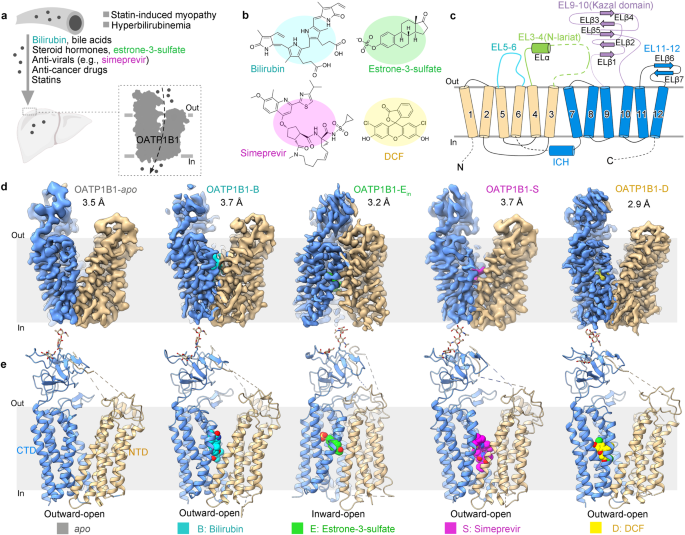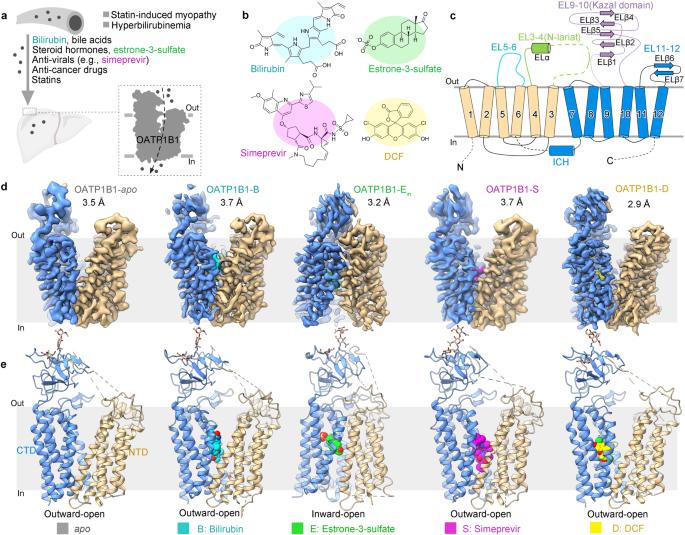Cryo-EM structures of human organic anion transporting polypeptide OATP1B1
IF 28.1
1区 生物学
Q1 CELL BIOLOGY
引用次数: 0
Abstract
Members of the solute carrier organic anion transporting polypeptide (OATPs) family function as transporters for a large variety of amphipathic organic anions including endogenous metabolites and clinical drugs, such as bile salts, steroids, thyroid hormones, statins, antibiotics, antivirals, and anticancer drugs. OATP1B1 plays a vital role in transporting such substances into the liver for hepatic clearance. FDA and EMA recommend conducting in vitro testing of drug–drug interactions (DDIs) involving OATP1B1. However, the structure and working mechanism of OATPs still remains elusive. In this study, we determined cryo-EM structures of human OATP1B1 bound with representative endogenous metabolites (bilirubin and estrone-3-sulfate), a clinical drug (simeprevir), and a fluorescent indicator (2′,7′-dichlorofluorescein), in both outward- and inward-open states. These structures reveal major and minor substrate binding pockets and conformational changes during transport. In combination with mutagenesis studies and molecular dynamics simulations, our work comprehensively elucidates the transport mechanism of OATP1B1 and provides the structural basis for DDI predictions involving OATP1B1, which will greatly promote our understanding of OATPs.


人有机阴离子转运多肽OATP1B1。
溶质载体有机阴离子转运多肽(OATP)家族的成员充当多种两亲性有机阴离子的转运蛋白,包括内源性代谢产物和临床药物,如胆汁盐、类固醇、甲状腺激素、他汀类药物、抗生素、抗病毒药物和抗癌药物。OATP1B1在将这些物质运输到肝脏以进行肝脏清除方面起着至关重要的作用。美国食品药品监督管理局和欧洲药品管理局建议对涉及OATP1B1的药物相互作用(DDI)进行体外测试。然而,OATP的结构和工作机制仍然难以捉摸。在这项研究中,我们确定了人OATP1B1与代表性内源性代谢产物(胆红素和雌激素-3-硫酸盐)、临床药物(西莫匹韦)和荧光指示剂(2',7'-二氯荧光素)结合的冷冻电镜结构,这些结构处于外向和内向开放状态。这些结构揭示了运输过程中主要和次要的底物结合口袋和构象变化。结合诱变研究和分子动力学模拟,我们的工作全面阐明了OATP1B1的转运机制,并为涉及OATP1Bl的DDI预测提供了结构基础,这将极大地促进我们对OATP的理解。
本文章由计算机程序翻译,如有差异,请以英文原文为准。
求助全文
约1分钟内获得全文
求助全文
来源期刊

Cell Research
生物-细胞生物学
CiteScore
53.90
自引率
0.70%
发文量
2420
审稿时长
2.3 months
期刊介绍:
Cell Research (CR) is an international journal published by Springer Nature in partnership with the Center for Excellence in Molecular Cell Science, Chinese Academy of Sciences (CAS). It focuses on publishing original research articles and reviews in various areas of life sciences, particularly those related to molecular and cell biology. The journal covers a broad range of topics including cell growth, differentiation, and apoptosis; signal transduction; stem cell biology and development; chromatin, epigenetics, and transcription; RNA biology; structural and molecular biology; cancer biology and metabolism; immunity and molecular pathogenesis; molecular and cellular neuroscience; plant molecular and cell biology; and omics, system biology, and synthetic biology. CR is recognized as China's best international journal in life sciences and is part of Springer Nature's prestigious family of Molecular Cell Biology journals.
 求助内容:
求助内容: 应助结果提醒方式:
应助结果提醒方式:


